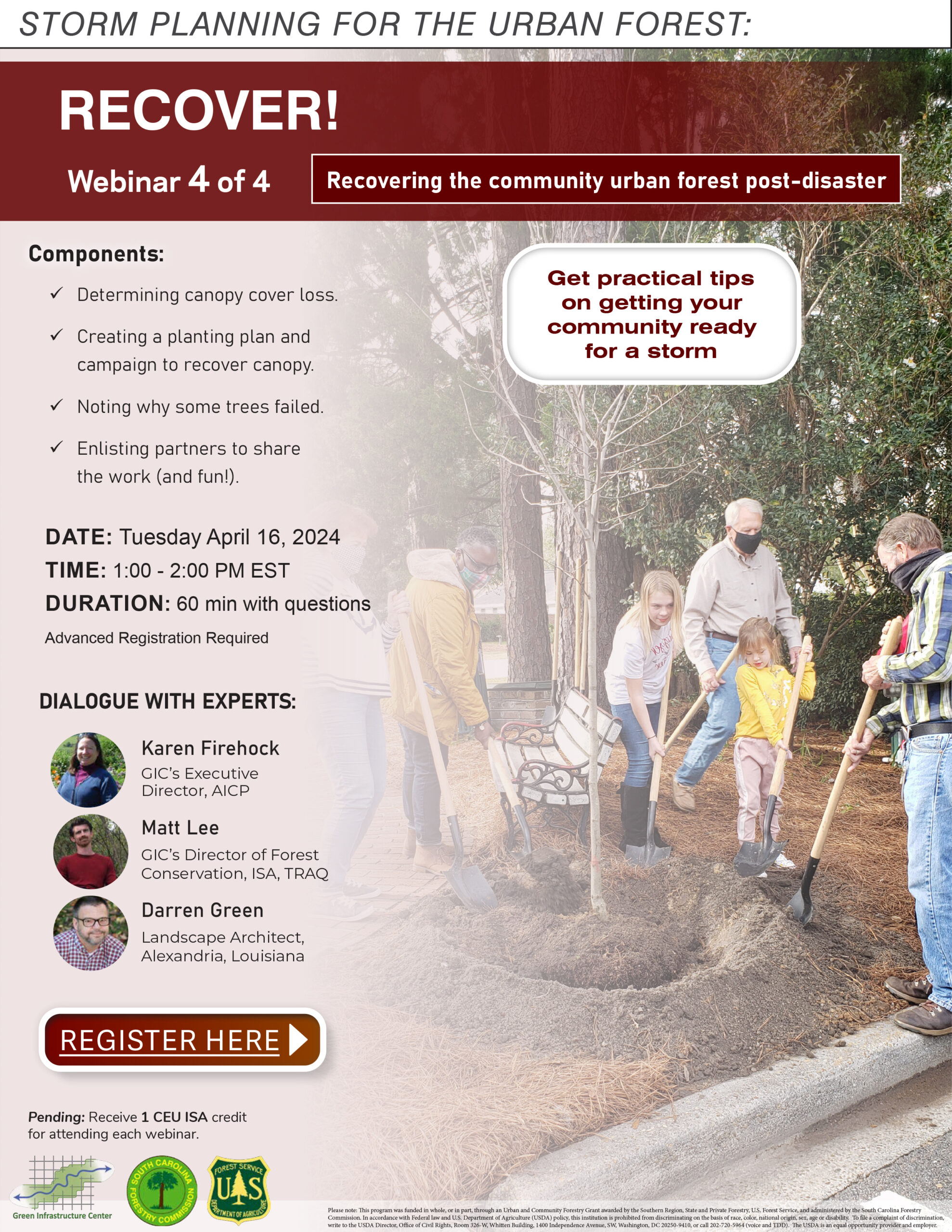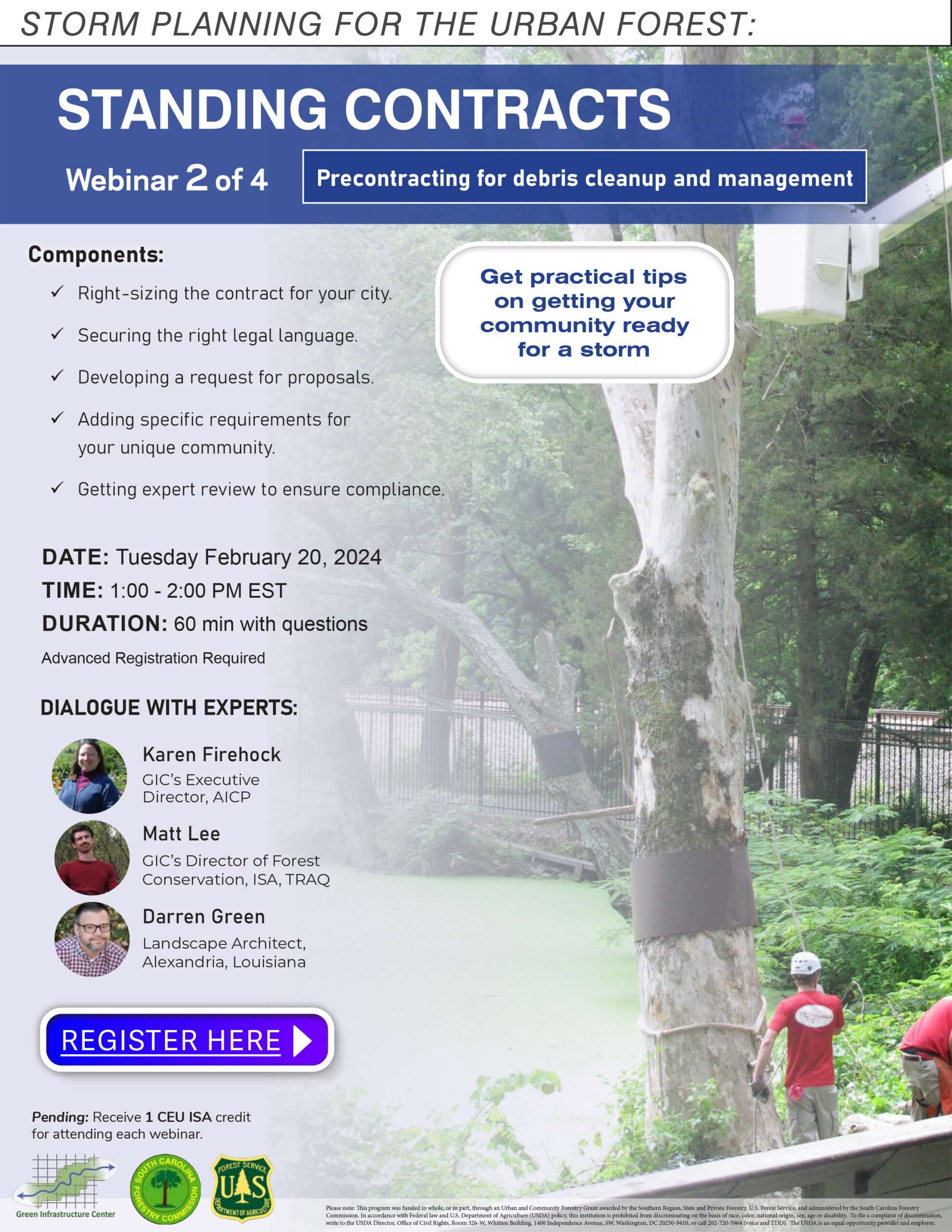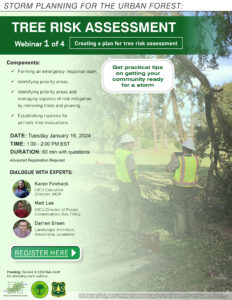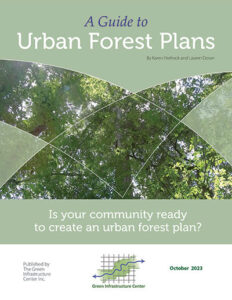If you missed our four part storm planning webinar series you can watch the recorded webinars here: https://www.scfc.gov/management/urban-forestry/community-forestry-webinars/
Webinars
Storm Planning for the Urban Forest Webinar 4: Recovery
 Webinar 4 Recovery: April 16th, 2024; 1:00 – 2:00 pm EST
Webinar 4 Recovery: April 16th, 2024; 1:00 – 2:00 pm EST
Recover; restore the urban forest after a storm event! In this final webinar in our four part storm series, we will discuss tree canopy loss after a storm event as well as ways to restore the community’s tree cover. We are getting better at responding to storms and cleaning up, but what about assessing impacts to our tree cover after storm damage? Trees need to be replanted and some trees will need additional care to continue to survive. This webinar will describe pre and post event monitoring, tree planting campaigns, and how to ensure a robust urban forest going forward. Led by GIC’s executive director Karen Firehock, AICP, GIC’s director of Forest Conservation Matt Lee, ISA, TRAQ and Darren Green, Landscape Architect, Alexandria Louisiana.
Pending approval this webinar will provide 1 free CEU ISA credit.
REGISTER HERE
Storm Planning for the Urban Forest Webinar 3: Debris Management Sites
 Webinar 3 Debris Management Sites: March 19th, 2024; 1:00 – 2:00 pm EST
Webinar 3 Debris Management Sites: March 19th, 2024; 1:00 – 2:00 pm EST
Respond; effectively manage storm debris during a disaster! In this third webinar in our storm series, we will explain the parameters and location specifications needed for a debris management site and how to calculate the space needed based on the volume of debris generated in a storm event. Efficiently storing, managing, and processing storm debris is crucial to ensure your community is not overwhelmed by the volume of debris generated by a storm. Ensure all permits are in place to designate the debris management site and how to monitor for quality assurance to allow for full FEMA reimbursement. Led by GIC’s executive director Karen Firehock, AICP, GIC’s director of Forest Conservation Matt Lee, ISA, TRAQ and Darren Green, Landscape Architect, Alexandria Louisiana.
Pending approval this webinar will provide 1 free CEU ISA credit.
REGISTER HERE
Storm Planning for the Urban Forest Webinar 2: Standing Contracts
 Webinar 2 Standing Contracts: February 20th, 2024; 1:00 – 2:00 pm EST
Webinar 2 Standing Contracts: February 20th, 2024; 1:00 – 2:00 pm EST
Get response ready; create standing debris contracts before a disaster strikes! Ensure your community has contracts in place to manage the debris from a future disaster. This second webinar in the series covers standing contracts (also called advance readiness contracts) and explains essential elements to include and how to create them. Having the right contracted firms in place ensures your community is ready to manage the next declared disaster and to be reimbursed by FEMA. Learn how to include your city or towns’ unique specifications before bidding. Get your community back on its feet faster and ensure FEMA reimburses the maximum possible amount. Led by GIC’s executive director Karen Firehock, AICP, GIC’s director of Forest Conservation Matt Lee, ISA, TRAQ and Darren Green, Landscape Architect, Alexandria Louisiana.
Pending approval this webinar will provide 1 free CEU ISA credit.
REGISTER HERE
Storm Planning for the Urban Forest Webinar 1: Tree Risk Assessment
 Webinar 1 Tree Risk Assessment: January 16, 2024; 1:00 – 2:00 pm EST
Webinar 1 Tree Risk Assessment: January 16, 2024; 1:00 – 2:00 pm EST
Get storm ready; assess tree risk before a disaster strikes! This first webinar in our series reviews the steps to assess and address risks to your urban forest before disaster strikes. Tree risk assessment involves creating dialogue with emergency management personnel, developing a storm team, and identifying priority areas for assessment. To conduct a risk assessment, communities will be guided through who to hire, the three levels of assessment, and how to use the urban tree risk index. This webinar will also cover the importance and logistics of mitigating risk by removing trees and pruning, establishing timelines for periodic reevaluation, and performing periodic routine tree evaluations. Led by GIC’s executive director Karen Firehock, AICP, GIC’s director of Forest Conservation Matt Lee, ISA, TRAQ and Darren Green, Landscape Architect, Alexandria Louisiana.
Pending approval this webinar will provide 1 free CEU ISA credit.
REGISTER HERE
A Guide to Urban Forest Plans: Are you ready to create an urban forest plan?
 Webinar: Nov 14, 2023; 1:00 – 2:00 pm EST
Webinar: Nov 14, 2023; 1:00 – 2:00 pm EST
Planners, Urban Foresters, and City Leaders are invited to join the South Carolina Forestry Commission and the Green Infrastructure Center for a webinar on Urban Forest Plans. Come learn about the benefits of planning for and managing the urban forest as well as the different types of urban forest plans. We will share a self-assessment tool for communities to determine where their urban forestry program falls in a tiered system and what the next steps are for strengthening their program. We will discuss what data a community should have to inform their urban forest plan and a recommended planning sequence. Finally, we will discuss components of a plan and the planning process. [Read more…] about A Guide to Urban Forest Plans: Are you ready to create an urban forest plan?
Tree Campaigns: Make your town greener, cleaner and healthier!
Webinar: Dec 9, 2021; 10:00 – 11:00 am EST
Many town and city planners, community tree groups, arborists and garden clubs know that trees are essential to creating liveable communities that are cooler, cleaner and more attractive. However, we all struggle with maintaining our canopy as trees age and die, or storms, floods and pests take away our trees bit by bit. Cities often run out of room on government-owned land to meet planting goals. Tree campaigns are one solution to engage the broader public in planting! This webinar will showcase new ways to motivate planting by linking it to healthier communities, reducing flooding and revitalizing the urban landscape. [Read more…] about Tree Campaigns: Make your town greener, cleaner and healthier!
Using trees to manage stormwater at the watershed and site scales.
Webinar: Dec. 2, 2021; 1:00 – 2:00 pm EST
A case study of Baton Rouge, LA.
As our landscapes continue to develop and become increasingly impervious, the power of trees to capture and infiltrate stormwater is often under-appreciated. More often than not, trees are some of the last solutions considered when designing and constructing a new development, but that doesn’t need to the case. Estimates for the amount of water a typical tree can intercept in its crown, range from 760 gallons to 4000 gallons per tree per year, depending on species and age. [Read more…] about Using trees to manage stormwater at the watershed and site scales.